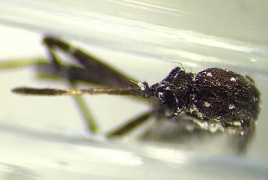
A novel mosquito carrying parasites or pathogens harmful to humans was discovered on Guantanamo Bay for the first time in June 2019, the BBC says in an article.
The American base on Guantanamo Bay, Cuba is best known as the place where the U.S. indefinitely confines suspects in its “war on terror”, without due process or trial.
The mosquito is called Aedes vittatus. One of 3,500 mosquito species found across the globe, it is a new addition to the dozen or so species in North America that carry parasites or pathogens harmful to humans. Other mosquito species, like Aedes albopictus and Aedes aegypti, can transmit diseases like dengue, yellow fever and chikungunya. But unlike those others, Aedes vittatus is capable of carrying nearly all of the most dangerous mosquito-borne diseases, except for malaria.
The Aedes vittatus is endemic to the Indian subcontinent and has never been seen in the western hemisphere until now. The mosquito is “a proven vector of chikungunya, Zika, dengue, yellow fever viruses and many other diseases”, according to the team of scientists who discovered it.
Most likely, the first specimens traveled the western hemisphere as eggs on a shipping container or possibly aircraft. The species’ likely proliferation across the Caribbean and the southern U.S. will be equally manmade: climate change is shortening North American winters, allowing mosquitoes to breed many more times in a single season and thus spread viruses further afield.
Months after the discovery, scientists’ fears that the mosquito may be proliferating even beyond Cuba came true when two specimens were discovered in the Dominican Republic, 260 kilometres east of Cuba. Even more alarming, these specimens didn’t share the same molecular makeup of the ones from Guantanamo. Rather, these intruders seem to have been independently transported from Southeast Asia.
Part of what makes mosquitoes so tricky to control is that “they can adapt to habitat and human objects”, says Yvonne-Marie Linton, research director of the Walter Reed Biosystematics Unit and curator of nearly 2 million specimens in the Smithsonian Institution’s US National Mosquito Collection. “We put bird baths in our garden, we have small children’s pools, and this is where this mosquito is found.”
Making matters worse, Aedes vittatus mosquitoes bite during the day. That means that some personal protection methods most people would think of – such as closing doors, using mosquito nets on beds at night, or covering up come dusk – are ineffective.
Military movements or industrial shipping may have brought Aedes vittatus to the western hemisphere. But human-accelerated climate change is helping the species – which loves warm, wet weather, exactly the kind that many regions are seeing more of – continue to thrive.
A mosquito will lay eggs about 36 hours after biting its host and, if the host was infected, can pass along the virus. It will produce 100-120 eggs that will hatch already carrying the disease.
Humans, however, are not helpless. Biosurveillance processes like that in Guantanamo can help us predict, and then head off, where diseases are spread. But unless robust, coordinated biosurveillance programs are funded around the world, by the time a new disease vector is discovered, it may be too far along to stop, says Linton.

